

Anchor charts away! - NeverEndingSearch. Jennifer LaGarde’s anchor chart board Anchor charts make learning sticky and visible.
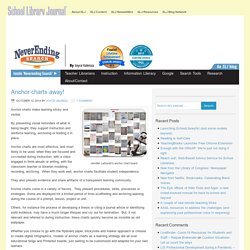
By presenting visual reminders of what is being taught, they support instruction and reinforce learning, anchoring or holding it in place. Anchor charts are most effective, and most likely to be used, when they are focused and co-created during instruction, with a class engaged in think-alouds or writing, with the classroom teacher or librarian modeling, recording, archiving. When they work well, anchor charts facilitate student independence. They also present evidence and share artifacts of a transparent learning community. Anchor charts come in a variety of flavors. Others, for instance the process of developing a thesis or citing a journal article or identifying solid evidence, may have a much longer lifespan and cry out for lamination. Creating Digital Anchor Charts in Flipgrid — @TheMerrillsEDU. Anchor Charts 101: Why and How to Use Them, Plus 100s of Ideas (WeAreTeachers) You won’t find Anchor Charts 101 in most teacher training programs.
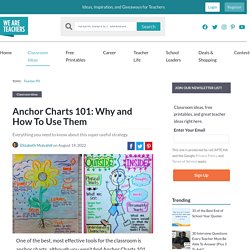
But they are one of the best, most effective tools for the classroom. If you’re new to teaching, you may have lots of questions about what anchor charts are, what purpose they serve, how to get started, and when to use them. That’s why we’ve created this primer to inform you. We’ve also included a huge list of resources to get you started. We have a feeling once you get started, anchor charts are going to your favorite go-to strategy. What is an anchor chart? SOURCE: Teaching With Simplicity An anchor chart is a tool used to support instruction (i.e.
How do I create anchor charts? You really don’t need any special materials or artistic skills—just chart paper and a colorful assortment of markers. It’s easy to incorporate anchor charts into your lesson plans. As you model a lesson or learning strategy and interact with your students through discussion, you fill in the blank spaces of the anchor chart. A few helpful tips: Anchor Charts as an Effective Teacher/Student Tool. Back in the day, it would not be unusual to enter a classroom, especially in the elementary grades, and catch a glimpse of store-bought educational charts displayed on the walls, windows, and bulletin boards.
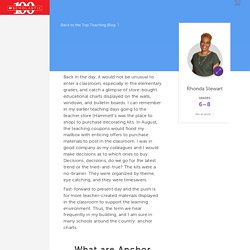
I can remember in my earlier teaching days going to the teacher store (Hammett’s was the place to shop) to purchase decorating kits. In August, the teaching coupons would flood my mailbox with enticing offers to purchase materials to post in the classroom. I was in good company as my colleagues and I would make decisions as to which ones to buy. Decisions, decisions, do we go for the latest trend or the tried-and-true? The kits were a no-brainer. Fast-forward to present day and the push is for more teacher-created materials displayed in the classroom to support the learning environment. What are Anchor Charts? Simply put, an anchor chart is a tool used largely to support instruction and to move the student towards achieving success with lessons taught in class. 30 Awesome Anchor Charts to Spice Up Your Classroom. Bored Teachers, LLC (“Bored Teachers,” “we,” “us,” “our”) provides its services (described below) to you through its website located at www.boredteachers.com (the “Site”) and through its related services (collectively, such services, including any content, new features, and applications, and the Site, the “Service(s)”), subject to the following Terms of Service (as amended from time to time, the “Terms of Service”).
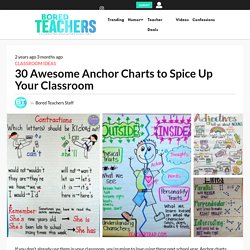
We reserve the right, at our sole discretion, to change or modify portions of these Terms of Service at any time. If we do this, we will post the changes on this page and will indicate at the top of this page the date these terms were last revised. Your continued use of the Service after the date any such changes become effective constitutes your acceptance of the new Terms of Service. Overview of the Service Your Registration Obligations You may register an account with Bored Teachers in order to access and use certain features of the Service. Anchor Charts for Writing. Anchor charts can be used very effectively to break down many of the more complex aspects of writing.
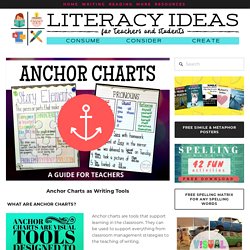
From punctuation use to the specific criteria for various writing genres, Anchor charts are a fantastic way to visually reinforce student understanding of these diverse processes. The content of each chart will, obviously, be dependent on their focus. But, let's take a look at the possible content of two example Anchor Charts to help serve as models for what might be contained in an anchor chart produced in your classroom. 1. Point of View Anchor Chart The Point of View Anchor Chart can be used both to help guide students in identifying the point of view in a text, as well as to help in the creation of the student’s own texts. Looking out for keywords is an effective way to determine the point of view in a piece of writing. Let’s take a look at some of the more common points of view used, first in a little detail and then how they might appear on an Anchor Chart.
30 Reading Anchor Charts Your Students Will Actually Use.